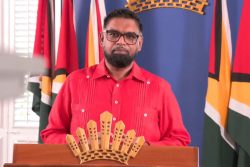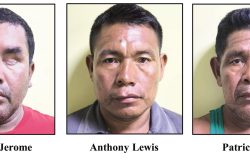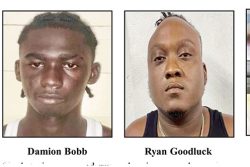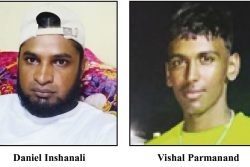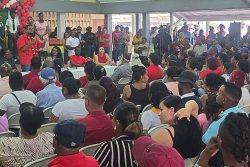By Winston McGowan
This second instalment of this article will give a brief account of the first three of the ten Test matches between the West Indies and Sri Lanka before the commencement of the visitors’ current tour of the Caribbean. A special focus will be placed on the performance of Guyanese players in these games.
The first-ever Test between the two teams took place in December 1993 (twelve years after Sri Lanka was accorded Test status in 1981) when the West Indies were world champions. This inaugural match (Sri Lanka’s 50th and the West Indies 300th) was staged at the Tyrone Fernando Stadium, Sri Lanka’s worst major ground. The game, ruined by rain and the venue’s inadequate drainage and pitch-covering facilities, was restricted to 11.5 hours’ play, even though it was extended to include the scheduled rest day after the opening day was abandoned. A full six hours’ play was possible only on the second day and not a ball was bowled on the last two days.
In spite of the weather and the fact that the match ended in a draw, the play on the turning pitch was enthralling and the low-scoring game was evenly poised when the last ball was bowled. Sri Lanka, led by Arjuna Ranatunga, won the toss, batted and was dismissed for 190. This modest total was due mainly to a courageous innings of 53 by the injured, talented but inconsistent middle-order batsman, Aravinda De Silva.
The best West Indian bowler was Winston Benjamin, who surprisingly eclipsed Curtly Ambrose and Courtney Walsh, extracting pace and bounce from a dead pitch and capturing four for 46 in 20 overs. The team’s spin bowlers, the Guyanese Roger Harper and Carl Hooper, each took one wicket for 36 and 44 runs off 24 and 20 overs respectively. It was the first time the West Indies played two spinners in a Test in almost five years, that is, since the Sydney Test in Australia in January 1989, when Harper and Hooper both failed to take a wicket, though each of them bowled 37 overs in the first innings.
This was Harper’s last Test for five years until his somewhat surprising recall in 1993 for the tour of Sri Lanka. In the inaugural single Test there he opened with a threatening seven-over spell of 1 for 1, but achieved no further success. Furthermore, batting at Number 7, he scored only three runs in the West Indies reply of 204 which gave them a slender 14-run lead over the Sri Lankans.
This lead was due mainly to a masterful innings of 62, the top score in the match, by Hooper, batting at Number 6. Coming to the wicket with the score at 84 for 4, Hooper, an excellent player of spin bowling, shared an invaluable fifth-wicket partnership of 84 runs with skipper Richie Richardson who made 51. According to the account of the highly respected commentator, Dicky Rutnagur, in the Wisden Cricketers’ Almanack, “Richardson played circumspectly for 203 minutes, and Hooper, using his feet to combat the turning ball, batted in commanding fashion until he had almost run out of partners; the last six wickets went down for 36 runs.” Among them was Harper, adjudged lbw to Sanath Jayasuriya for three. The four Sri Lankan spinners, led by Muttiah Muralitharan with four victims, took all ten wickets.
When the game ended, Sri Lanka was 43 for 2 in their second innings, in which Hooper did not bowl and Harper had only one over, conceding three runs without taking a wicket. Not surprisingly, this proved to be Harper’s last Test appearance. In a career of 25 Tests over ten years, dating back to his debut against India in the subcontinent in 1983, the Guyanese all-rounder captured 46 wickets at an average of 28.06 runs each, scored 535 runs with an average of 18.44, a highest score of 74 and two other half-centuries and took 36 catches
The second encounter between West Indies and Sri Lanka occurred three and a half years after the inaugural match when Sri Lanka made its first tour of the Caribbean to play two Tests in June 1997. In the interim the West Indies had been dethroned as world champions by Australia in 1995.
The Sri Lankans arrived in the Caribbean a month after India had left. It was the first time the West Indies hosted two Test series in a season. The Sri Lankan two-match rubber was a keenly contested affair, with the West Indies winning the first game in Antigua by six wickets and the second match at Amos Vale in St. Vincent ending in a draw. This was the first occasion a Test was played in a Windward Island.
In both matches the West Indies were led in the first innings. In the first game the home team had scores of 189 and 189 for 4 in reply to the visitors’ totals of 223 and 152. Their victory was due mainly to its penetrative bowling by Ambrose and impressive attacking batting by the openers, Sherwin Campbell (50 and 79) and Stuart Williams (21 and 83).
Ambrose had match figures of 8 for 78 (5 for 37 and 3 for 41). With his 18th five-wicket haul in 71 Tests, he became the twelfth bowler and fourth West Indian (after Lance Gibbs, Malcolm Marshall and his captain, Courtney Walsh) to reach the landmark of 300 Test wickets. Campbell and Williams had a scintillating opening stand of 160 in the second innings when the West Indies, set 187 for victory, reached the target before tea on the third day.
Sri Lanka also had a few good performances in a match where the batting of both sides left much to be desired. The opener, Sanath Jayasuriya, had the top score (85) in the game, sharing a fourth wicket century partnership (110 runs) with his captain, Arjuna Ranatunga, in the first innings. Furthermore, Muralitharan, like Ambrose, captured eight wickets, but at greater cost (106 runs), with figures of 5 for 34 and 3 for 72.
The only Guyanese in the West Indies team, Carl Hooper, performed moderately, scoring 27 and 6 not out and taking one wicket for 49 runs off 19 overs in the only innings in which he bowled. The team missed the consistent productive batting of another Guyanese, namely, Shivnarine Chanderpaul, recently their leading scorer against India but now unavailable because of a neck injury.
Hooper, given the Man of the Match award, was his team’s hero in the second Test which had a tense finish in bad light with the Sri Lankans needing 36 runs to win with only two wickets in hand. The West Indies, put in to bat by Sri Lanka who won the toss, were dismissed in 44 overs for a paltry total of 147. Most of the runs were made by Hooper, the only batsman to apply himself. He played an exquisite responsible innings of 81 which included one six and 10 fours.
In reply Sri Lanka was dismissed for 222 with the opener, Jayasuriya, making the top score, a typically aggressive 90 with 11 fours. The best West Indies bowler was Hooper who took five for 26 in 13.4 overs, his best figures in Test cricket. His victims included the top scorers, Jayasuriya and De Silva (35).
The West Indies, 75 behind, made 343 in their second innings, owing mainly to a match-saving century (115 with 11 fours and one six) by Brian Lara, who in his three previous innings in the rubber had had scores of 0, 4 and 1. It was his 10th century in 45 Tests and the first and only hundred in the rubber and enabled him to become the eleventh batsman to score 4000 runs in Tests for the West Indies.
Lara shared an important fourth-wicket stand of 97 with Hooper (34) which enabled their team to set Sri Lanka 269 to win. When poor light brought the game to an end, the visitors were 233 for 8, due mainly to good innings by De Silva (78) and Ranatunga (72 not out). Their competitiveness was also due to effective bowling by the off-spinner, Muralitharan (3 for 28 and 5 for 113) and the medium-fast opening bowler, Ravindra Pushpakumara (5 for 41 and 2 for 81).
In the rubber Hooper headed his team’s batting averages, scoring 148 runs in 4 innings with an average of 49.33. He was also second to Ambrose (11 wickets for 163 runs, average 14.81) in the bowling averages, with 6 wickets for 96 runs, average 16.00.
The leading Sri Lankan batsman was Jayasuriya with 192 runs in 4 innings and an average of 48.00. The best visiting bowler was Muralitharan who had the most victims on either side – 16 wickets for 247 runs at an average of 15.43 runs each.
Thus after the first three Tests between the West Indies and Sri Lanka in two encounters, the West Indies were ahead, with one victory and two draws. This situation would be reversed by the Sri Lankans in the following three series which will be the subject of the third and final instalment of this article.

